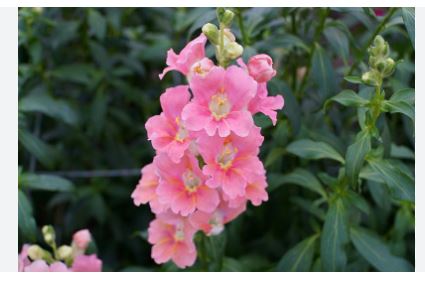
Antirrhinum is a genus of plants in the Plantaginaceae family, commonly known as dragon flowers or snapdragons because of the flowers’ fancied resemblance to the face of a dragon that opens and closes its mouth when laterally squeezed. They are also sometimes called toadflax or dog flower. They are native to rocky areas of Europe, the United States, Canada, and North Africa. Antirrhinum species are widely used as ornamental plants in borders and as cut flowers.
Snapdragons thrive in cooler temperatures, blooming best when nights are in the low 40s°F and days in the low 70s°F. They can be grown as annuals in most places or as perennials in USDA zones 7-1. They vary by species and cultivar; from as short as 6 inches for dwarf types to over 3 feet for taller varieties.The leaves are lance-shaped, green, sometimes with a grayish tint, and grow alternately along the stem.
Snapdragons have a unique flower structure known as a “bilabiate” or “two-lipped” corolla. The upper lip forms a hood, and the lower lip serves as a landing platform for pollinators. When the sides of the flower are gently squeezed, the lips open and close, mimicking a dragon’s mouth, which is how they got their common name.
The size of the flowers varies with the variety, but generally, each flower is about 1 to 1.5 inches long. Larger or smaller flowers can be found depending on the cultivar. The flowers can be single or double, with some modern hybrids displaying ruffled petals or contrasting ‘faces.’ Snapdragons come in a wide array of colors, including:
- Whites, creams, and ivories
- Pinks from soft pastels to bright fuchsias
- Reds from light to deep crimson
- Oranges, yellows, and golds
- Purples from lavender to deep violet
- Some varieties have bicolored or speckled patterns; for example, a yellow flower with a red throat or a solid color with a contrasting ‘face’.
The flowers are arranged in a spike or raceme at the top of the stem. This means they grow in a linear fashion along the stem, with the oldest flowers at the bottom and the youngest at the top, blooming progressively upwards. Each flower has five petals, with the upper one forming the hood or ‘dragon’s head’, and the other four forming the lower lip or ‘dragon’s jaw’. Inside the flower, there’s a nectar guide or ‘bee landing strip’ which is often a different color to guide pollinators to the nectar.
Some snapdragon varieties have a mild, sweet scent, but many are grown more for their visual appeal than their fragrance. Each individual flower lasts for about a week, but the spike will continue to bloom over several weeks, especially if deadheaded.
Snapdragon Cultivation
- Choose a location with full sun, at least 6 hours of direct sunlight daily. In very hot climates, some afternoon shade can be beneficial.
- Snapdragons prefer well-drained, fertile soil. The soil pH should be neutral to slightly alkaline, around 6.2 to 7.0.
- Planting should be done early in spring for a summer bloom, or in late fall for an autumn display in warmer climates.
- They require regular watering, but care should be taken to avoid wetting the foliage to prevent fungal diseases like rust.
- Pinching back the tips of young plants encourages bushier growth, and deadheading spent flowers can extend the blooming period.
- In zones where snapdragons are perennials, mulch heavily over winter to protect roots. In colder zones, treat them as annuals or dig up and overwinter indoors.
- Apart from seeds, snapdragons can be propagated through softwood cuttings taken in spring or early summer.
- Use a balanced, slow-release fertilizer at planting time. Supplement with liquid fertilizer every 4-6 weeks during the growing season for continuous blooming.
- Taller varieties might need staking to prevent them from falling over, especially if they are top-heavy with flowers or in windy conditions.
- Watch for aphids, slugs, and snails. Use insecticidal soap or neem oil for aphids, and slug bait or traps for slugs and snails.
Planting
- Indoor Starting: Sow seeds indoors 6-8 weeks before the last expected frost. Use a seed starting mix, barely cover the seeds with soil as they need light to germinate.
- Germination: Maintain a temperature of about 70°F (21°C). Seeds should germinate in 7-14 days.
- Transplanting: After the last frost, when seedlings have at least two true leaves, harden them off and transplant them outside.
- They can also be sown directly in the garden after the last frost. However, this might delay blooming.
- For dwarfs, space plants 6-8 inches apart; for taller varieties, 12-18 inches apart.